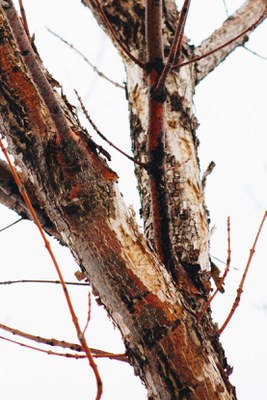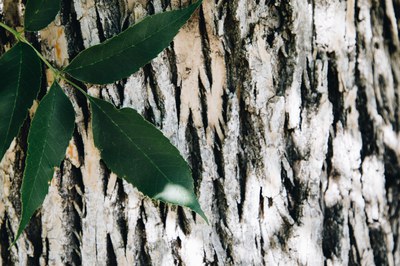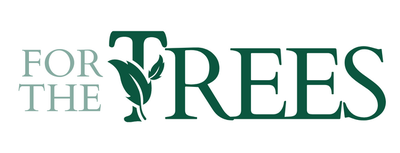Keeping an eye out for emerald ash borer

- A photo of one of the EAB-affected trees in Moorhead from March 2023, showing “blonding” on the right branch extending upward and a crack exposing S-shaped galleries on the left branch. This was taken towards the very top of the tree.
EAB attacks all types of ash trees in the genus Fraxinus, including green ash. Green ash comprises almost 30% of North Dakota conservation plantings, such as shelterbelts. This type of tree also makes up more than 60% of natural riparian forests in the state, and the average street tree population has almost 50% green ash. EAB larvae make S-shaped channels we call “galleries” in the phloem just beneath the bark and essentially choke out the life of the tree. No ash tree is safe, so this shows how important it is that North Dakotans monitor their own trees and keep an eye out for symptoms.
February is actually a great time to monitor for EAB-affected trees. The trees are bare of leaves, which would normally hide the bark and the signature D-shaped exit holes that EAB leaves in the tree. However, since these holes are only about ¼” across, they are not a great diagnostic tool, especially for the untrained eye of a homeowner or landowner. Instead, we encourage the public to keep an eye on the bark near the top of the ash tree.
One of the most noticeable “symptoms” is the flecking of bark on the top portion of the tree, a phenomenon we call “blonding”. This is due to woodpeckers and other foraging birds seeking out these larvae for a tasty treat. These larvae are usually found high up in the canopy, in branches where thin bark meets the more distinctive diamond shaped bark of the ash tree. Bark foraging birds sense the larvae under the bark and pull the bark off the tree with their beaks, leaving behind lighter colored “blonde” patches on the bark. This is often found more so on the south and west side of the tree, as the sun subtly heats the bark and makes it a more habitable place for the larvae to feed. Sometimes you’ll even see places where the back cracks open to expose the S-shaped galleries.
Homeowners and those with ash trees in their windbreaks are asked to monitor for these symptoms across the state.

- A photo of a green ash tree’s bark and leaf shape. The leaves are compound and opposite from each other on the branch, and green ash is known for its diamond shaped designs in the bark.
By Beth Hill, NDFS Outreach and Education Manager



